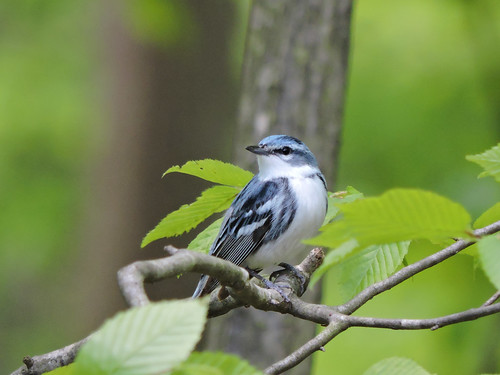
What do biologists look for in a healthy forest? A diversity in the ages and composition of trees and occasional breaks in canopy to allow sunlight to reach understory plants. Healthy forests, just like healthy human populations, are sustained by a diversity of ages. Each group has a role to play in maintaining the whole community over the long term.
But healthy, diverse forests are on the decline across the eastern United States. A lack of natural and human-induced disturbances because of fire suppression and certain timber harvest methods have led the forested landscape to become largely homogenous.
These declines have had negative impacts on many different wildlife species, especially birds – like the cerulean warbler – that use different types of forests for different parts of their life cycle. Through a new project, the Appalachian Mountains Joint Venture (AMJV) is working with landowners and conservation partners to sustainably manage healthier forests, benefiting the declining cerulean warbler.
“Because three-fourths of the cerulean warbler’s distribution occurs on private lands, working with private landowners in this region is critical to the successful conservation of this songbird,” AMJV Coordinator Todd Fearer said about the cerulean warbler, which nests and raises its young in the treetops above the Appalachian Mountains.
AMJV, a partnership to restore and sustain native bird populations in the region, is working with landowners in West Virginia, Maryland, Pennsylvania and Kentucky to provide assistance in managing healthier forests and restoring forests on mining sites. The AMJV is working with USDA’s Natural Resources Conservation Service (NRCS), American Bird Conservancy and more than a dozen other conservation partners to provide technical and financial assistance to help landowners plan and implement sustainable forestry practices.
“Fortunately, good cerulean habitat is best created using sustainable forestry practices that can improve the health of the forest stand and improve the future value of timber, so it’s a win for both the birds and the landowners,” Fearer said.

Landowners have found these practices help to “reset the clock” on low-value forests by re-establishing a healthier and more valuable stand of trees.
The project has a goal to improve the health of at least 12,500 acres in priority areas. In its first year, the project led to the improvement of about 1,700 acres. The AMJV is also monitoring the response to forest improvement, tracking the use of these managed lands by cerulean warblers and other species.
The Regional Conservation Partnership Program, a Farm Bill conservation program administered by NRCS, is investing $8 million in this project, and partners are leveraging an additional $8 million.
“One of the greatest strengths of the Migratory Bird Joint Ventures is the collective resources the partners bring to the table,” Fearer said. “We have more than 20 AMJV partners across five states assisting with this project, contributing direct, in-kind and logistical support. This gives us the opportunity to address a range of cerulean warbler conservation needs at a scale not feasible by any one organization.”
This project is part of a broader conservation effort in the East to help landowners manage for diverse forests. Through Working Lands for Wildlife (WLFW), NRCS has helped Appalachian landowners improve more than 13,000 acres for the golden-winged warbler, another iconic migratory songbird that relies on young forests for nesting.
“The Farm Bill provides landowners with a variety of tools to manage for more productive forests, including one-on-one technical assistance and financial assistance,” said Bridgett Costanzo, one of WLFW’s coordinators. “Every forest has different needs and resource challenges, and we work with landowners to tailor forest management plans to meet the needs of wildlife and their operations.”
Landowners wanting to participate in the AMJV’s effort for cerulean warbler are encouraged to reach out to the AMJV or their nearest USDA service center
